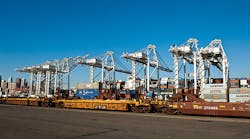Earlier this month it was leaked that the ports of Seattle and Tacoma are discussing merging to try to create efficiencies to combat the growing ports of Vancouver (Canada) and those in California. This comes right after nine long months of dispute that finally ended with West Coast port employers and union members reaching a tentative five-year agreement on a new contract. The two sides were praised for their compromise, and the ports were slated to resume full operations the following day. However, the need for increased efficiency and throughput—both in times of calm and times of disruption—is still very much there.
According to Peter Friedmann, executive director of the Agriculture Transportation Coalition in Washington, D.C., this specific port backup is projected to continue for two months or more, which will affect countless American workers, businesses and consumers. And, that’s not even taking into consideration the daily disruptions and slowdowns that occur in a normal operating week.
So what can the ports do to be more competitive and more resilient to disruptions? The answer is implementing technology to dynamically optimize their operations—in other words, use data already available to the ports to find the most efficient solution possible in the same way that they operate: in real-time, all the time.
The aviation industry is a perfect example of how companies are utilizing technology to plan ahead and then react in real-time to changes. In fact, some retailers and manufacturers turned to the air to move goods during the port shutdown. The aviation industry—similar to the ports—must function within an environment that is not only highly regulated, but also prone to ongoing changes and disruptions like changing customer demand, mechanical failures, employee illness and weather.
The aviation industry has turned to dynamic optimization that provides real-time optimal plans for both planning ahead and reacting to ongoing changes. While ports crawl through backlog trying to recover, and discuss potential mergers to gain some competitive advantages, the aviation industry can react to disruptions, like unexpected sick time and weather, all while using minimal resources to meet demand and reduce fuel burn and emissions. The result? A 16% reduction in operating costs and 20% increase in capacity using their existing resources. Time and money saved—two things the ports could benefit from.
To clarify, this is not about reducing equipment or staff. That would be the ‘easy’ obvious answer because while it might cut costs for a port, it will not do much for the economy or employees. This is about addressing better planning and reacting to change, in real-time, of the use of the equipment and staff, so that increased throughput is enabled in the port. In fact, when applied correctly, this will lead to top-line growth in any given port and thus probably to hiring of more staff.
Optimizing operations could make a difference of millions, if not billions, of dollars. Beyond the pure dollar impact, harnessing this type of technology will help ensure the longevity of importers and exporters, employers and employees, and the economy as a whole.
Until the ports have implemented a system to optimize their operations, they will continue to be held hostage by inefficiency and inertia. The model for this new streamlined operation is out there, and it’s working. The question is whether or not the ports will follow the trend and get on board.
Roei Ganzarski is the CEO of BoldIQ, an operations optimization software company for aviation, ground transportation and staffing.



